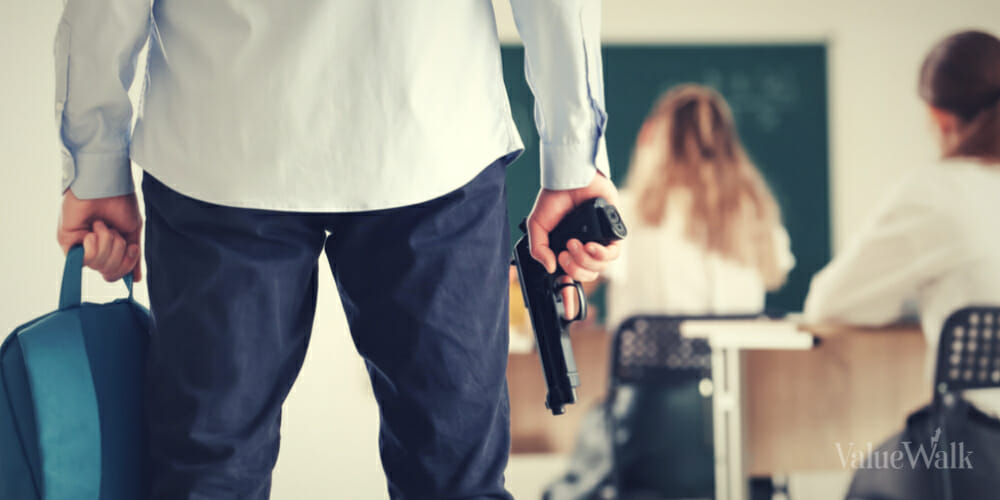MSU Students Had to Barricade Doors, Unnecessarily; Universal Shooter-Safety Recommendation – Classroom Door Locks – Ignored
MSU Students Were Forced To Construct Makeshift Barricades
WASHINGTON, D.C. (February 14, 2022) – Media reports indicate that many students at Michigan State University [MSU], upon learning of an active shooter on campus and being told by authorities to shelter in place, were forced to try to construct makeshift barricades to block doors to protect their lives.
Q4 2022 hedge fund letters, conferences and more
This should have been unnecessary, says professor and security consultant John Banzhaf, who notes that dozens of experts and organizations have strongly recommended that universities have locks or latches which permit classroom and other doors to be locked from the inside in the event of a campus-shooter alert.
If students had to put up what in too many cases prove to be ineffective makeshift barriers to block doors, it means that MSU did not take this elementary, proven, simple, and very inexpensive precaution to protect its student and faculty - something which could have taken no more than 20 minutes and $20 per door, says Banzhaf.
He is the author of a report on simple yet inexpensive steps universities should take now to protect students and faculty from the increasingly foreseeable shooter on campus. See:
- University World News - How Can Universities Tackle The Threat Of Active Shooters?
- Washington Examiner - 11 solutions to thwart school shootings
Here's what other experts are saying about the need for locks on classroom doors:
The Sandy Hook Advisory Commission recommended that "all classrooms in K-12 schools should be equipped with locked doors that can be locked from the inside."
Likewise, the National Association of State Fire Marshals - which has frequently expressed concerns about children or even teachers not being able to escape in time in the event of a school fire, or of first responders not being able to reach people trapped inside.
Nevertheless strongly recommends that "to help protect teachers and students in the classroom, the classroom door should be lockable from inside the classroom without requiring the door to be opened."
The GUARDIAN has reported that "once a shooter is in a building, most security experts agree getting into a locked room is one of the most effective deterrents against getting injured or shot." Indeed, in no school shooting incident has a locked classroom door been breached, since the gunman doesn't want to waste time trying to force it open, and shooting a lock off is easier said than done.
Similarly USA TODAY advised that "security experts say locks go a long way toward keeping out danger. You have to think in terms of we've got to have the least amount of tragedy and the most amount of saving, and that may be this key situation, . . . Interior locks may have saved lives during a 2005 school shooting on the Red Lake Indian Reservation in Minnesota."
And the magazine CAMPUS SAFETY urged its readers that "it is vital for staff to be able to successfully secure classrooms from the inside to protect students from potential threats."
Here's more:
Inside Higher Ed - Locking Out Danger *** Should college classroom doors have ability to lock from the inside?: "In general, doors that lock from the inside have been in place on college campuses for several years, said Jesus M. Villahermosa Jr., president of Crisis Reality Training, which advises organizations on handling emergencies.
He said that while it is impossible to eliminate risk entirely, in his experience "locks absolutely work. People are able to secure themselves in rooms and shooters haven't been able to get to them."
ABC News - Classroom Doors That Don't Lock Add to UCLA Shooting Scare : "Some students at UCLA were forced to create makeshift barricades because they were unable to lock classroom doors Wednesday when the school went into lockdown during an active-shooter situation. Beyond that, many of the doors opened outwardly, making it even more difficult to secure them against what was feared to be an active shooter."
UCLA shooting renews concerns about classrooms with no locks: "Yet once an active shooter is in a building, most security experts agree getting into a locked room is one of the most effective deterrents against getting injured or shot.
"How many deaths would it have taken for us to address this issue more seriously?" said Jesus Villahermosa, president of Crisis Reality Training, noting that an assailant, knowing police are on the way, usually won't bother trying to access a locked room."
"The National Fire Protection Association's life safety code adopted in 38 states does NOT prohibit putting locks on doors, division manager Robert Solomon said. But there are certain types of locks schools must install. Solomon said the types of locks found in many hotel rooms are an effective example. The door can be bolted from the inside but it opens in one motion when the handle is turned."
Campus Safety - Best Practices for Securing Classroom Doors from the Inside: "Whether facing an active shooter emergency or another type of lockdown situation in school, it is vital for staff to be able to successfully secure classrooms from the inside to protect students from potential threats.
At Sandy Hook Elementary School, the classroom doors could only be locked from the outside, forcing teachers to walk out into the hallway and potentially into the line of fire in order to secure their classroom.
So it appears that MSU, like so many universities, did not take this universally-recommended step to protect students and faculty in the event of an active shooter on campus.
This one simple and inexpensive precaution can help save lives, as well as shield a university from massive legal liability should a shooter enter a classroom and kill a student because it didn't have a $20 lock, says the law professor.





